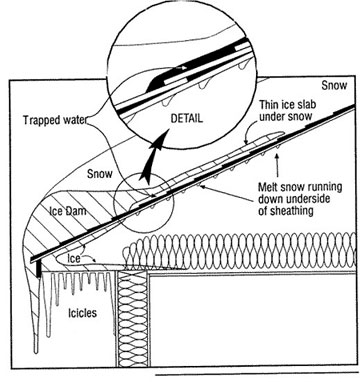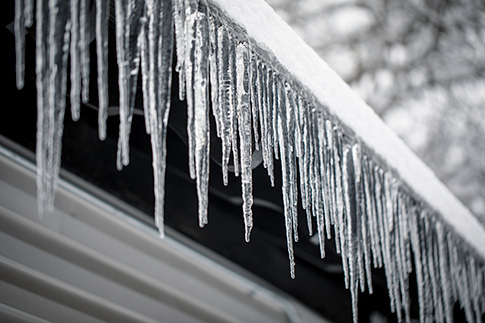Ice damming on roofs: zero tolerance!

Do you have icicles decorating your house? Has ice built up and formed a barrier at the edge of your sloped roof? Beware: these are signs of a serious issue. If you don’t take action, you face a water infiltration problem.
Why is there ice at the edge of your roof?
This phenomenon is known as ice damming, and it happens when two conditions are met:
- Snow has built up on the roof; and
- The temperature of the roof covering is above 0ºC.
Most often, heat loss from the house is what causes the roof covering to warm up. A spell of warm weather can also be the reason, of course.
If there’s snow on the roof and the temperature then dips below freezing, an ice dam can form as follows:
- The bottom layer of snow or ice on the roof melts because of the heat.
- The melt water runs down the roof.
- The water freezes once it reaches the roof overhang, which is colder then the rest of the roof.
- That ice builds up and forms a dam at the roof edge.
Why is an ice dam a problem? Because it traps water above it. That water has nowhere to go, so it seeks another path: under the shingles or tiles. Often it seeps into the attic and outside walls. The diagram below provides a good illustration.

Source: Canada Mortgage and Housing Corporation
Once water seeps in, the damage is done. Insulation, wall and ceiling coverings, paint, masonry—nothing will be immune to deterioration. It’s therefore essential that you act promptly, before the water does its dirty work. Learn what to do in case of water damage.
What to do if an ice dam forms on your roof
Has ice formed a barrier at the edge of your roof? In an emergency situation, the best way to limit damage is to open channels in the ice near the roof edge. This will allow the water to run off. Pour hot water onto the ice dam in the direction in which water normally flows off the roof.
Important: Don’t try to cut or break the ice with an axe or other tool. You could easily damage the roof covering.
Other situations can result in damage to your house. Read how to prevent problems related to storms, and what to do if there is damage.
How to keep ice from forming on your roof
To keep icicles and ice dams from forming at the edge of your roof, you have a few options:
Removing snow from the overhanging parts of the roof is an effective method. No snow means no ice dams! This takes time and energy, however. And if you’d rather entrust the chore to a specialist, be prepared to pay.
Installing electric heating cables is another proven method. The cables keep ice from forming and allow water to run off normally. You can choose an automated system, which ensures that the cables switch on by themselves whenever conditions are conducive to ice formation. The rest of the time, they’ll stay switched off. That way, you can’t leave them on by mistake and waste electricity.

How to permanently fix a problem with ice
If ice dams on your roof are caused by heat loss from your house, the wisest solution is to tackle the problem at its source.
Stop heat migration into the attic
If heat is escaping from your house through the roof, you’ll need to add ceiling insulation or seal air leaks, or do both.
Locate the places where air (and therefore heat) may be getting through. The most common ones are around the trap door to the attic and the various elements that pass through the insulated ceilings, such as plumbing and ventilation ducts, recessed lighting fixtures, and chimneys.
Buy sealant, weather stripping, expanding foam insulation, etc., according to your needs. These materials are usually inexpensive and easy to apply.
Make sure the attic is properly ventilated
Any warm air and humidity that do infiltrate the attic space must be vented to the outside. In addition, there must be inlets for outside air at the base of the roof. This air exchange is calibrated according to factors like the surface area of the ceiling insulation and the roof slope.
Perforated soffits below the roof overhang allow outside air into the attic. If needed, rigid foam or cardboard deflectors can be installed in the attic to allow air to flow freely between the insulation and the underside of the roof. Static aerators, meanwhile, are roof vents that draw air out by a “chimney effect.” To work effectively, they must be installed as close as possible to the roof ridge. If your roof isn’t adequately ventilated, don’t hesitate to consult a professional to remedy the situation.
Good to know
A comprehensive (“all-risks”) insurance policy covers the costs of a roof collapse.
Your insurer may also cover you for damage due to water infiltration. You must, however, add the Water Damage – Above-Ground Water endorsement to your insurance policy. Learn more about what types of water damage your homeowner's insurance covers.

Benefit from personalized advice
Do you have questions about your home, need specific information, or are you looking for referrals to find an Approved Supplier?